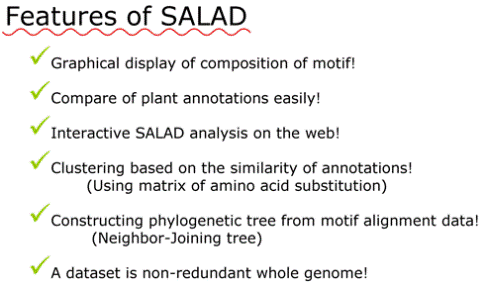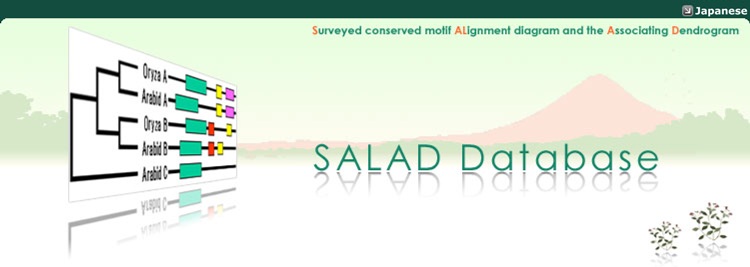What is SALAD?
■Introduction
|
Genomic sequence data is now available in several plant species. Although coding protein sequences have been annotated in such genomes based on cDNA sequence information, homologies with known proteins, and computational gene prediction, many of their biological and biochemical functions are not well predicted. We therefore hypothesize that evolutionarily conserved amino acid sequences (or motifs) in homologous proteins would reflect biochemical functions of the annotated proteins. Therefore, to provide hints to elucidate the function of annotated proteins, we have established a genome-wide database of similarity clustering based on distribution patterns of such motifs found in three datasets; the first set (ver. 1.0) is 83,508 proteome annotation sequences of three plant species: Arabidopsis thaliana, rice (Oryza sativa), and red alga (Cyanidioschyzon merolae), the second set (ver. 2.0) is 168,869 proteome annotation sequences of seven plant species: A. thaliana, rice, the red alga, sorghum, the moss, green alga (Ostreococcus tauri) and yeast (Saccharomyces cerevisiae), and the last one(ver. 3.0) is 250,687 proteome annotation sequences of ten plant species: A. thaliana, rice, the red alga, sorghum,the moss,the green alga, yeast, grape (Vitis vinifera), lycophyte (Selaginella moellendorffii), and another green alga (Chlamydomonas reinhardtii). The database is termed SALAD (Surveyed conserved motif ALignment diagram and the Associating Dendrogram) database. |
■Purpose
|
Genome-wide comparative analysis of annotated protein sequences in plant.
|
 |
■Features

What is motif? |
■Current dataset
Version and species information
 Details of ver. 3.0
Details of ver. 3.0
 Details of ver. 2.0
Details of ver. 2.0
 Details of ver. 1.0
Details of ver. 1.0
Dataset (ver. 3.0)
Ref:LSDB(http://lifesciencedb.jp), JGI(http://www.jgi.doe.gov/) ・RAP-DB (http://rapdb.dna.affrc.go.jp/) ・JGI (http://genome.jgi-psf.org/) ・TAIR (http://www.arabidopsis.org) ・Cyanidioschyzon merolae Genome Project (http://merolae.biol.s.u-tokyo.ac.jp/) ・SDG Saccharomyces Genome Database (http://www.yeastgenome.org/) ・Vitis project (http://www.genoscope.cns.fr/externe/GenomeBrowser/Vitis/) Dataset (ver. 2.0)
*In this SALAD database ver. 2.0, many monocot- specific motifs can be extracted as common motifs found in both two monocot species (rice and sorghum). Meanwhile, some dicot- specific motifs may not be extracted because ver. 2.0 data set contains only one dicot data (A. thaliana). ・RAP-DB (http://rapdb.dna.affrc.go.jp/) ・JGI (http://genome.jgi-psf.org/) ・TAIR (http://www.arabidopsis.org) ・Cyanidioschyzon merolae Genome Project (http://merolae.biol.s.u-tokyo.ac.jp/) ・SDG Saccharomyces Genome Database (http://www.yeastgenome.org/) Dataset (ver. 1.0)
・RAP-DB (http://rapdb.dna.affrc.go.jp/) ・MIPS (http://mips.gsf.de/proj/plant/jsf/athal/index.jsp) ・Cyanidioschyzon merolae Genome Project (http://merolae.biol.s.u-tokyo.ac.jp/) |
■Instructions and directions for use
|
|

